I am a fabric junkie. I love the look, feel, and textures of fabrics of all kinds. In fact, I think that part of the reason I collect, wear, and sell vintage clothing is for love of fabric. The right fabric makes a good design better, and can turn a mediocre design into a masterpiece.
We “vinties” love our silks and rayons, don’t we? But today I’m going to talk about polyester. Yup, that omni-present synthetic “stuff” that appeared en masse in the mid 60s and seemed to be all anyone made clothes out of for about the next decade.
Alas, polyester has a bad rep—in some cases. In others, its reputation as an evil fabric is deserved. Many buyers, sellers, and collectors of vintage apparel shudder at the thought of polyester. I assume they associate all polyesters with the cheap double-knit polys we saw in the “mature-women” pantsuits and outlet-store clothing of that era. Often it was spongy and “saggy,” and when you bent your knee, it didn’t bend back with you. So you walked around all day with knee molds in your slacks!
However, polyester was/is a very well-rounded fiber that lends itself to a variety of fabric types: single-knit jerseys, better-quality double knits (such as today’s ponte knits), wovens, and pile fabrics. It also blends well with cottons, linens, and rayons—its better characteristics offset the less-desirable ones of those fabrics. For example, a cotton/poly blend won’t wrinkle or shrink like 100 percent cotton will. Linen will drape better and wrinkle less, and rayon is more readily washed and stronger in a blend with poly.
Polyester can be made to mimic many other fibers—we all know today’s smooth, lightweight polys that feel almost exactly like silk, but yesterday’s could be just as nice. I worked in a fabric store in the 70s, and we had high-end polyesters in shantung weaves, crepe-backed satins, drapey jerseys, soft double-knit crepe, fabulous jacquards, etc. Polyester opened up a world of easy-care clothing for the busy career woman: Most everyday fabrics were washable and didn’t need ironing. Throw them in the washer, toss in the dryer, hang, and wear. One could say that if polyester had not been introduced for commercial use in clothing, women would have been even more harried as they embarked upon the modern “Superwoman” path.

And polyester was not relegated to the world of cheap and moderate ready-to-wear fashion. Many, many high-end labels and famous designers used it back then, and still do so today. So, if you think of vintage poly as being the low rung of the fabric ladder, think again!
1970s’ men’s Lilly Dache polo shirt, typifying the wild prints we saw in that era; sold by VFG member Catseye Vintage.
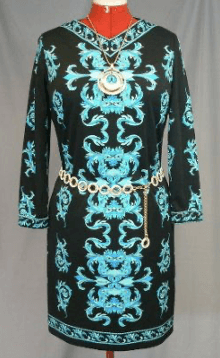
Some designers who were noted for their polyester creations were Mr. Dino, who was noted for the use of very fine polyester jersey; Goldworm; and, of course, Pucci.
Dress by Mr. Dino, sold by VFG member Vintage Baubles
But of course, there are the everyday pieces. There are the designer items that are, shall we say, a bit more “70s’ trendy”; and some uses that had been primarily the domain of fabrics such as silk, rayon, acetate, and nylon.
1970s’ polyester lent itself incredibly well to the wild prints, bright (some would say “loud”) colors, and outlandish styles of the ‘70s. The skirts of maxi dresses draped nicely when done in a good poly knit, wide collars laid softly on the bodice, and screen prints took well to poly knits. Polyester can be knitted into textures such as linen, crepe, jacquard, and fine sweater-style weaves; these can add a lot of interest to a piece. Here are some that exemplify the era of 70s’ polyester, some for better, and some for worse. And be sure to check out the note of interest at the bottom!
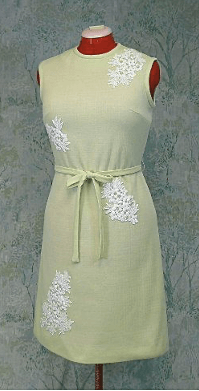
Mid-range makers such as R & K (the label for “the girl who knows clothes”) used a lot of poly knits and some woven polys, but often “dressed” them up with an interesting weave and/or design elements or embellishments. This pastel green knit dress is a good example, with a linen texture and beautiful lace appliqués.
R & K dress, sold by VFG member Vintage Baubles
Not only do these two knit dresses feature big collars, but both have zip fronts and fabulous prints
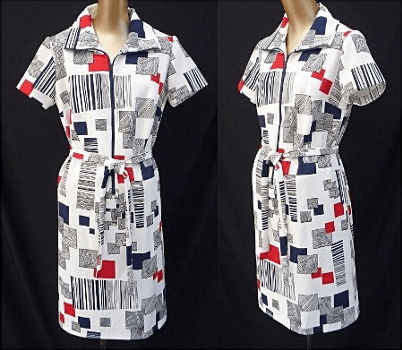
Atomic-print dress, sold by VFG member Catseye Vintage
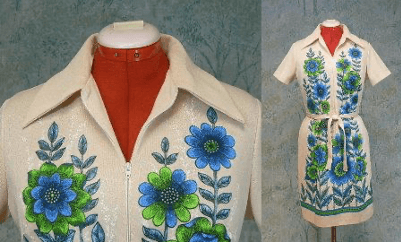
Screen-printed dress, sold by VFG member Vintage Baubles
And some very well-known designers fell into following the trends, as shown with the dress below, as many designers did.
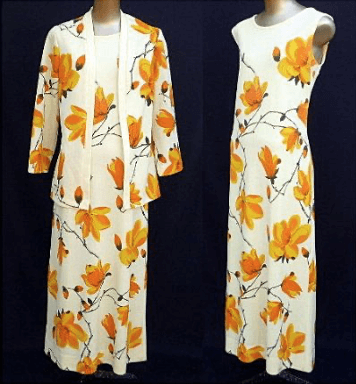
Alfred Shaheen maxi dress and jacket, sold by VFG member Catseye Vintage
While this dress is a surprising treat from a generally conservative label:
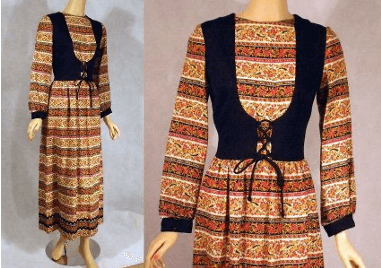
Gay Gibson maxi dress, sold by VFG member Alley Cats Vintage
The 70’s also ushered in the widespread use of polyester in lingerie, a trend that continues today. Woven poly can mimic rayon or silk satin, as well as different types of silk, and taffeta. It gave a new dimension to traditional lingerie!
Watch for more fabric discussions from The Fabric Junkie! In the meantime, here are our final poly pieces, epitomizing what most people think of when they think of 60’s and 70’s polyester.
This dress has it all: brown and orange colorway; two, not one, crazy prints; tie collar… a quintessential 1970s’ polyester knit dress:
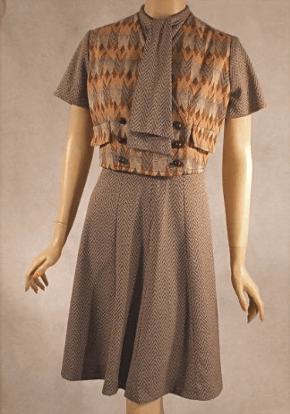
Two-tone brown poly dress, sold by VFG member Alley Cats Vintage
And these butt-ugly 100% poly wide ties (though we think the one on the right is pretty cool, it’s pretty awful, too), infamously unique to the era:
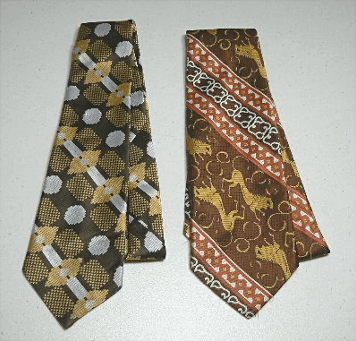
From VFG member Vintage Baubles
We’ll leave you with this interesting tidbit of history: Singer/musician Jackson Browne and his pal David Lindley, on their 2010 tour, created a campaign, “Show Me the Polyester,” which encouraged fans to submit photos of themselves wearing polyester. The best dressed (or worst, depending on your POV), a fellow from New Jersey, won a trip and front-row seats to the duo’s September 14, 2010, concert at New York’s Beacon Theatre. Pretty far out (as we’d say in the ’70s).